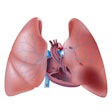VIENNA - Nearly one in five coronary CT angiography scans acquired with an emerging high-pitch dual-source CT angiography (DSCTA) protocol needs to be repeated for a variety of reasons related to patients' heart rhythms, researchers from Spain reported at the European Congress of Radiology (ECR).
However, the low-dose acquisitions possible with the technology mean even repeated scans have lower overall doses than comparable 64-detector-row CTA scans, they said.
On a dual-source 128-detector-row scanner, prospectively gated high-pitch scans of the entire heart can be acquired in a single beat, provided the patient has a heart rate below 65 beats per minute and a high pitch of 3.4 is used.
The protocol delivers a table speed of 160 mm per second and a mean radiation dose of approximately 1 mSv for the entire exam, said Dr. Gonzalo Tardáguila de la Fuente, from Povisa Hospital. But compared to conventional MDCT scans, several stars have to align to obtain optimal image quality using the high-pitch technique.
"We need a prediction of the [electrocardiogram (ECG)], and if it works well we have high image quality with a low radiation dose," de la Fuente said. But patients' heart rates aren't always predictable and, in fact, they can change immediately before the image is acquired, producing image artifacts and in some cases nondiagnostic images -- and sometimes even the need for a new scan, he said.
"Once we realized the problem, we decided to determine the number of scans that we need to repeat, why we need to repeat them, and the type of acquisition we performed in the second study," de la Fuente said during Friday's CT angiography sessions.
The study examined 403 patients using coronary CTA; scans for 229 (57%) of the patients were acquired using high-pitch dual-source CT (Definition Flash, Siemens Healthcare). The researchers used a rotation speed of 0.28 sec, 3.4 pitch, 320 mAs tube current, and 100, 120, or 140 kVp for patients weighing less than 80 kg, more than 80 kg, or who had previous coronary stenting, respectively.
Of the 229 high-pitch exams acquired in 2009 and 2010, the investigators found that 40 (17%) needed to be repeated. They classified the cause of the repetition into three groups:
- Rhythm alteration at the moment of acquisition: 26 (65%)
- Isolated extrasystole: 9 (23%)
- Unclear (good ECG, but unexplained poor image quality): 5 (12%)
The type of second acquisition was also calculated -- often the high-pitch study could be repeated, de la Fuente said. The nonrepeated studies had a mean dose of 1.23 ± 0.49 mSv versus the higher values of the repeated scans, as follows:
- Repeated high pitch: n = 27 (68%), mean 2.8 ± 1.4 mSv
- Repeat scan retrospectively triggered: n = 9 (22%), mean 7.53 ± 3.72 mSv
- Repeat scan prospectively triggered: n = 4 (10%), mean 5.51 ± 2.3 mSv
"This is how practice works in our center; other practices may have different experiences," he said. But the center's doses are very low compared to published studies showing MDCT radiation doses of 12 mSv or higher.
"The important thing is that when we repeat the studies, we are around 4 mSv -- less than half of the radiation we would have given patients when using 64-detector-row CT," de la Fuente said. So even though approximately 17% of high-pitch DSCT studies need to be repeated, the radiation dose remains lower than with conventional imaging.
"We think the clinical relevance of the study is that even though we have to repeat a relatively high number -- 17% -- of the studies, the radiation dose is so low that we think it should be considered the first option in patients [with heart rates] below 65 beats per minute," he said.



















